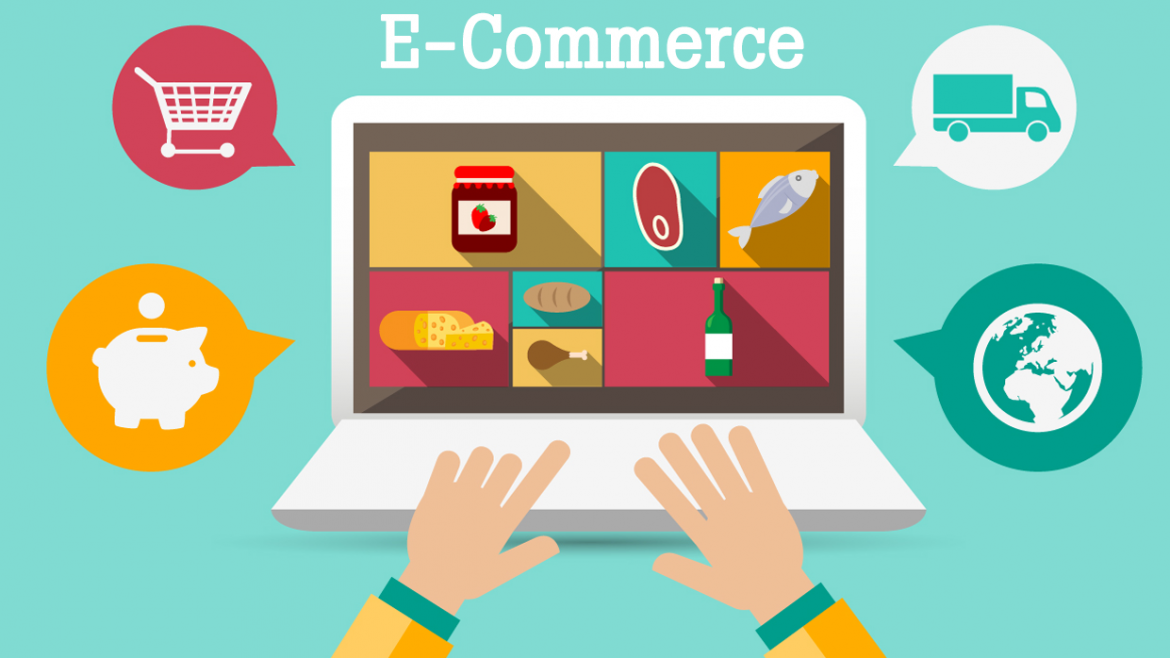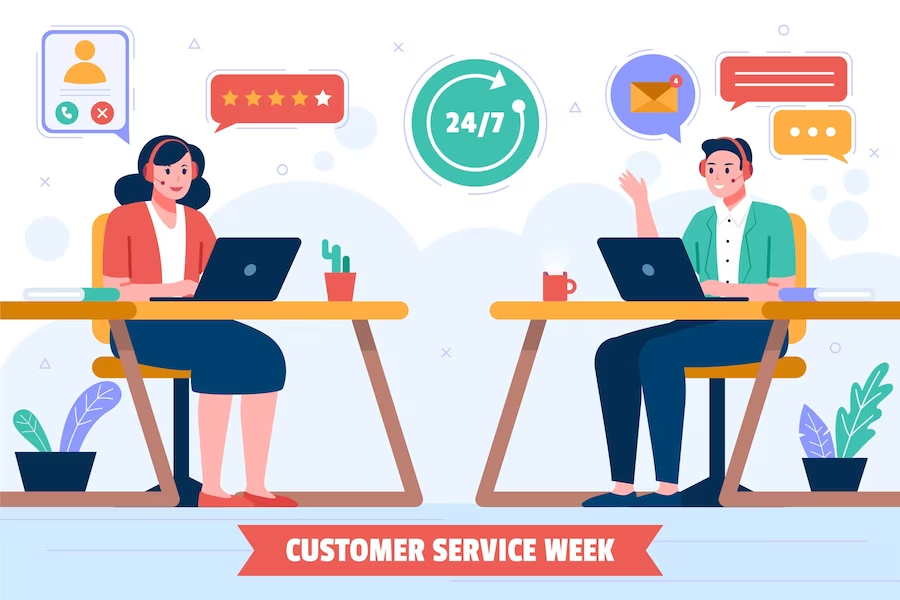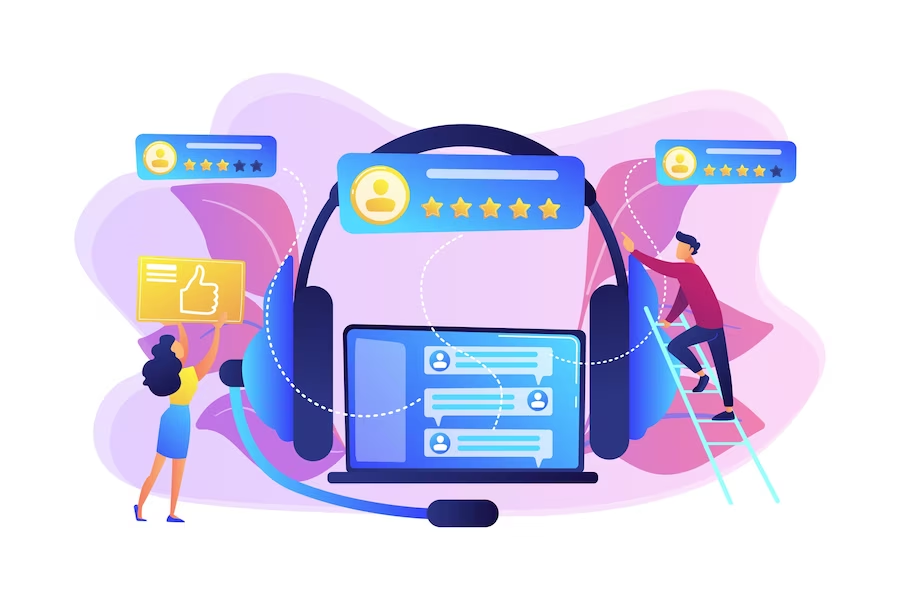Crafting effective eCommerce customer service: 8 recommended practices

Where digital storefronts have replaced traditional brick and mortar shops, the role of eCommerce customer service has taken center stage. Customers can browse, compare, and purchase products from a vast array of online retailers, enjoying the convenience of shopping from the comfort of their homes with the button click. However, as the digital marketplace expands and becomes increasingly competitive, the significance of effective eCommerce customer service cannot be overstated. eCommerce offers unparalleled convenience and access to a world of products. Yet, it also presents unique challenges, such as the absence of in-person interactions. In this virtual realm, where trust and satisfaction are forged through digital touchpoints, crafting exceptional eCommerce customer service experiences is not just a choice; it’s a necessity. This article delves into the intricacies of crafting effective eCommerce customer service. We will explore 8 recommended practices that can craft effective eCommerce customer service.
Importance of eCommerce customer service
The significance of effective eCommerce customer service cannot be overstated, as it greatly influences the success and long-term sustainability of an online business. Here are several key reasons underscoring the importance of quality customer service in eCommerce.
- Customer retention: Exceptional eCommerce customer service builds customer loyalty. When customers have positive experiences and receive the support they need, they are more likely to return for future purchases. This reduces customer churn and increases the lifetime value of a customer.
- Positive reviews and referrals: Satisfied customers are not only more likely to make repeat purchases but also more inclined to leave positive reviews and recommend your business to others. These reviews and referrals can significantly impact your online reputation and attract new customers. Efficient tools, such as AI receptionist, provide consistent and personalized support, further improving the customer service experience.

- Problem resolution: eCommerce is not without its challenges. From shipping issues to product inquiries, customers often encounter problems. Effective eCommerce customer service can swiftly resolve these issues, preventing disputes, chargebacks, and negative feedback.
- Competitive advantage: In a crowded marketplace, eCommerce customer service can be a crucial differentiator. When customers receive attentive, helpful, and personalized service, they are more likely to choose your business over competitors.
- Building trust: Trust is fundamental in e-commerce. Customers need to trust that their personal information is secure, that products will arrive as described and on time, and that they can rely on your business for support. Effective eCommerce customer service contributes to building and maintaining this trust.
- Market insights: Customer interactions provide valuable insights into market trends, preferences, and areas for improvement. By actively engaging with customers, you can gather feedback that informs your product offerings and business strategies.
- Enhanced brand image: A reputation for outstanding eCommerce customer service can become a hallmark of your brand. It signals to customers that you are committed to their satisfaction and can enhance your brand image in the eyes of consumers.
- Repeat business: Customers who are content are more inclined to become returning customers.. By providing excellent service, you not only secure initial sales but also increase the chances of ongoing business from the same customers.
8 best practices eCommerce customer service to follow
Personalized and customer-centric service
Importance of personalized and customer-centric service
- Enhanced customer satisfaction: When customers perceive that your business comprehends their individual requirements and preferences, their satisfaction with the shopping experience increases, which, in turn, can result in repeat business and loyalty.
- Increased customer loyalty: Personalization fosters a sense of connection and loyalty. Customers are more likely to return to a brand that remembers their preferences and offers tailored recommendations.
- Higher conversion rates: Personalized product recommendations and content can significantly increase conversion rates. When customers come across products that match their interests, their likelihood of making a purchase increases.
- Reduced cart abandonment: Personalized offers and reminders can help reduce cart abandonment rates. Sending targeted emails or notifications to customers who left items in their cart can encourage them to complete the purchase.
- Improved cross-selling and upselling: Through an understanding of customers’ prior actions and preferences, you can discern potential opportunities for cross-selling related products or upselling higher-value items.
- Efficient marketing: Personalized marketing campaigns are more efficient and cost-effective. Instead of sending generic messages to your entire customer base, you can target specific segments with messages that resonate with their interests.

Implementing personalized and customer-centric service
- Collect and analyze data: Start by collecting relevant customer data, including purchase history, browsing behavior, and demographic information. Utilize analytics tools to acquire insights into customer preferences.
- Segment your audience: Segment your customer base into groups based on shared characteristics or behavior. For example, you can create segments for new customers, repeat buyers, or customers interested in specific product categories.
- Personalized product recommendations: Use recommendation algorithms to suggest products based on a customer’s browsing and purchase history. Showcase these recommendations prominently on your website or within your email communications.
- Tailored email marketing: Craft personalized email campaigns that speak directly to each segment’s interests. Use the customer’s name, recommend products, and provide relevant content.
- Responsive customer support: Train your customer support team to provide personalized assistance. Encourage them to use the customer’s name, reference past interactions, and offer solutions tailored to the customer’s specific issue.
- Feedback and surveys: Gather feedback through surveys and customer reviews. Use this information to make improvements and tailor your offerings.
- Dynamic website content: Implement dynamic content on your website that changes based on the user’s behavior and preferences. This can include personalized homepage recommendations and targeted landing pages.
Multichannel interaction and convenience
Importance of multichannel interaction and convenience
- Customer choice: Different customers have different preferences for communication. Some may prefer live chat, while others prefer email or social media. Offering multiple channels allows customers to choose the method that suits them best.
- Accessibility: Multichannel support ensures that your business is accessible to a broader audience. Customers from various demographics and regions can reach out in ways that are most convenient for them.
- Improved response times: By offering multiple channels, you can distribute customer inquiries more effectively. This can lead to faster response times and quicker issue resolution.
- Enhanced customer experience: Convenience is a key element of a positive customer experience. When customers can easily reach your business through their preferred channel, they are more likely to have a satisfying experience.

Implementing multichannel interaction and convenience
- Identify relevant channels: Determine which communication channels are most relevant to your target audience. Consider options like email, live chat, phone support, social media, messaging apps, and self-service portals.
- Consistent branding: Ensure that your branding, messaging, and tone are consistent across all channels. This creates a unified and recognizable customer experience.
- 24/7 availability: If possible, offer round-the-clock support or self-service options. Many customers appreciate the flexibility of being able to get assistance at any time.
- Multichannel integration: Implement an omnichannel strategy that allows for a seamless transition between channels. For example, a customer can start a conversation on live chat and continue it via email without having to repeat information.
- Empower your team: Train your customer support team to effectively manage inquiries across various channels. Equip them with the tools and knowledge needed to provide consistent and quality service.
Enhancing feedback and payment processes
Importance of enhancing feedback and payment processes
- Customer insight: Customer feedback provides valuable insights into their experiences and preferences. It helps you understand what’s working well and where improvements are needed.
- Continuous improvement: Feedback is the cornerstone of continuous improvement. It allows you to make data-driven decisions and refine your products, services, and customer interactions in eCommerce customer service.
- Conversion rate optimization: Streamlined payment processes can improve your conversion rates. A complicated or confusing checkout process can lead to cart abandonment.
- Reduced friction: Smooth payment processes reduce friction in the customer journey. When customers can complete transactions quickly and easily, they are more likely to make purchases.

Implementing enhancing feedback and payment processes
- Request feedback: Actively request feedback from customers through channels like post-purchase emails, surveys, and follow-up inquiries. Make it easy for customers to share their opinions.
- Implement feedback tools: Utilize feedback tools and platforms that enable customers to leave reviews and ratings. Display these reviews prominently on your website.
- Listen and respond: Pay close attention to customer feedback, both positive and negative. Respond promptly to inquiries and concerns, demonstrating your commitment to customer satisfaction.
- Streamline checkout: Simplify the checkout process by minimizing the number of steps and required fields. Offer guest checkout options for customers who prefer not to create accounts.
- Multiple payment options: Provide payment options to accommodate customer preferences. This may include credit/debit cards, digital wallets, and alternative payment methods.
- Secure payment gateway: Invest in a secure and reputable payment gateway to protect customer data. Display trust symbols and communicate your commitment to security.
Efficient delivery and post-purchase services
Importance of efficient delivery and post-purchase services
- Customer expectations: In the fast-paced world of e-commerce, customers expect prompt and reliable delivery. Meeting or exceeding these expectations can lead to higher customer satisfaction.
- Competitive advantage: Efficient delivery and post-purchase services can be a significant differentiator in a competitive market. Businesses that provide quick and hassle-free delivery often stand out.
- Reduced cart abandonment: A streamlined and efficient checkout process can help reduce cart abandonment rates. When customers see a clear delivery timeline and convenient options, they are more likely to complete their purchase.
- Customer loyalty: Reliable post-purchase services, including tracking, returns, and support, can foster customer loyalty. Customers are more likely to return if they have a positive overall experience.

Ensuring efficient delivery and post-purchase services
- Accurate delivery information: Provide accurate and clear delivery information, including estimated delivery times, shipping costs, and tracking details. Set realistic expectations to avoid disappointment.
- Multiple delivery options: Offer various delivery options, including standard, express, and same-day delivery, if possible. Enable customers to select the option that best fits their requirements and budget.
- Inventory management: Implement effective inventory management practices to ensure products are in stock and readily available for fulfillment. Avoid overselling or extended backorders.
- Efficient packing: Optimize your packing process to minimize waste and reduce the risk of damage during transit. Use eco-friendly materials when possible.
Customer segmentation and classification
Importance of customer segmentation and classification
- Personalization: Segmenting customers enables personalized marketing and communication. You can create personalized messages and offers that resonate with each segment, increasing the chances of engagement and conversion.
- Targeted marketing: By understanding the unique characteristics of each segment, you can allocate your marketing budget more effectively. This prevents wasteful spending on generic campaigns that may not reach the right audience.
- Improved customer retention: Segmentation allows you to identify high-value customers and focus efforts on retaining them. You can provide special incentives and offers to loyal customers, strengthening their loyalty.
Implementing customer segmentation and classification
- Data collection: Gather relevant customer data, including demographics, purchase history, browsing behavior, geographic location, and psychographic information. Use surveys, analytics tools, and customer profiles to collect this data.
- Segmentation criteria: Define the criteria for segmentation, such as age, gender, location, purchase frequency, or product preferences. Consider using a combination of criteria for more precise segments.
- Segment identification: Use data analysis tools to identify distinct customer segments based on the defined criteria. Common segments may include loyal customers, occasional buyers, high-spenders, and first-time shoppers.
- Profile creation: Create detailed customer profiles for each segment, outlining their characteristics, behaviors, and preferences. Understand what motivates each segment to make purchases.
Ensuring security and privacy
Importance of ensuring security and privacy
- Customer trust: Security and privacy measures instill confidence in your customers. When they trust that their personal and financial information is safe with your business, they are more likely to make purchases.
- Data protection: Protecting customer data is not only an ethical responsibility but also a legal requirement in many regions. Adherence to data protection regulations such as GDPR (General Data Protection Regulation) is crucial in order to prevent legal repercussions.
- Reduced risk: Implementing robust security measures reduces the risk of data breaches, fraud, and cyberattacks. This, in turn, helps prevent financial losses and reputational damage.
Implementing security and privacy measures
- Secure website: Ensure that your e-commerce website uses HTTPS encryption to protect data transmitted between the customer’s browser and your server. Regularly update your website’s security protocols.
- Payment security: Use reputable payment gateways that are Payment Card Industry Data Security Standard (PCI DSS) compliant. Avoid storing customer payment information unless absolutely necessary.
Read more: What is PCI compliance? Why is it important?
- Data encryption: Encrypt sensitive customer data, including payment details and personal information, both in transit and at rest. Encryption ensures that even if data is intercepted, it remains unreadable.
- Regular software updates: Keep all software, including content management systems (CMS), plugins, and extensions, up to date to patch vulnerabilities that cybercriminals may exploit.
Brand building and effective communication
Importance of brand building and effective communication
- Brand recognition: A well-defined brand identity helps customers recognize and remember your business. This recognition can lead to trust and loyalty.
- Differentiation: In a competitive market, a strong brand sets you apart from competitors. It helps customers understand what makes your business unique and why they should choose you.

Implementing brand building and effective communication
- Define your brand identity: Clearly define your brand’s values, mission, and unique selling points. Comprehend what distinguishes your business from competitors.
- Logo and visual identity: Create a distinctive logo and visual identity that aligns with your brand’s personality. Consistency in design elements, colors, and typography is essential.
- Brand Storytelling: Craft a compelling brand story that resonates with your target audience. Communicate the journey, values, and mission of your business through storytelling.
- Content strategy: Develop a content strategy with your brand identity. Create content that educates, entertains, and engages your audience while reflecting your brand’s voice and values.
- Consistent messaging: Ensure consistency in messaging across all communication channels, including your website, social media, email marketing, and advertising. Consistency builds trust.
Performance measurement and continuous improvement
Importance of performance measurement and continuous improvement
- Data-driven decision-making: Performance measurement provides valuable data that informs your business decisions. It helps you identify what’s working and what needs improvement.
- Optimized operations: Regular evaluation allows you to identify bottlenecks and inefficiencies in your e-commerce processes. By addressing these issues, you can optimize your operations and reduce costs.
- Enhanced customer experience: Monitoring customer feedback and behavior helps you tailor your offerings and services to meet their needs. This results in a better customer experience and increased loyalty.
- Adaptation to market changes: eCommerce is a dynamic field with evolving trends and technologies. Continuous improvement allows you to adapt to market changes and stay competitive.
- Profit maximization: By identifying areas where you can improve efficiency or increase sales, you can maximize your profitability.
Implementing performance measurement and continuous improvement
-
Define key performance indicators (KPIs): Identify the specific metrics and KPIs that are most relevant to your business goals. Common e-commerce KPIs include conversion rate, average order value, customer acquisition cost and customer retention rate.
- Data collection and analysis: Implement tools and processes for data collection and analysis. Use analytics platforms to track KPIs and customer behavior. Regularly review the data to gain insights.
- Benchmarking: Compare your performance metrics to industry benchmarks and competitors. This helps you understand your field.
- A/B testing: Conduct A/B testing to evaluate different strategies, such as website design, pricing, or product descriptions. Compare the performance of variations and implement changes based on the results.
Conclusion
Throughout this guide, we’ve emphasized the importance of understanding your customers, building a strong brand, ensuring security and privacy, and continuously measuring and improving your e-commerce operations. Success in the e-commerce world requires adaptability, customer-centricity, and a commitment to delivering exceptional experiences. By applying these principles and continually refining your strategies, your eCommerce business can thrive, attract loyal customers, and attain sustainable growth within a competitive marketplace. Whether you’re just starting out or looking to enhance your existing e-commerce venture, these insights provide a solid foundation for success.






![Top 20+ Must-have Shopify Apps for 2025 [Free & Paid] - Mageplaza](https://cdn2.mageplaza.com/media/blog/must-have-shopify-apps/top-must-have-shopify-apps.png)
![[2025 Updates] Top 10+ Upsell Apps for Shopify - Mageplaza](https://cdn2.mageplaza.com/media/blog/best-upsell-shopify-app/cover.png)